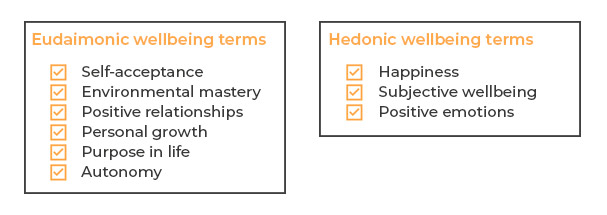
What is psychological wellbeing?
At Robertson Cooper, our focus is on creating more Good Days at Work and that is partly driven by ensuring employees have good psychological wellbeing. Let’s take a look at what we mean by that.
At the most basic level, psychological wellbeing (PWB) is quite similar to other terms that refer to positive mental states, such as happiness or satisfaction, and in many ways it is not necessary, or helpful to worry about fine distinctions between such terms. If I say that I’m happy, or very satisfied with my life you can be pretty sure that my psychological wellbeing is quite high!
Psychological wellbeing has two important facets. The first of these refers to the extent to which people experience positive emotions and feelings of happiness. Sometimes this aspect of psychological wellbeing is referred to as subjective wellbeing (Diener, 2000).
Subjective wellbeing is a necessary part of overall psychological wellbeing but on its own it is not enough.
To see why this is so, imagine being somewhere that you really enjoy, perhaps sitting on a yacht in the sunshine, with your favourite food and drink and some good company – or alone if that’s how you’d prefer it! For most people that would be very enjoyable, for a week or two but imagine doing it not just for a week but forever! There are very few people who would find that prospect enjoyable. The old saying may be true, you can have too much of a good thing. What this example brings home is that to really feel good we need to experience purpose and meaning, in addition to positive emotions.
So, the two important ingredients in psychological wellbeing are the subjective happy feelings brought on by something we enjoy AND the feeling that what we are doing with our lives has some meaning and purpose.


Theories about psychological wellbeing generally focus on understanding the structure of psychological wellbeing or the dynamics (i.e. the causes and consequences of PWB). The breakdown of psychological wellbeing into hedonic and eudaimonic components and Carol Ryff’s model are widely accepted theories of the structure of PWB.
As far as the dynamics of PWB are concerned it’s important to recognise that, to some extent, PWB is relatively stable and will have been influenced by both previous experience (including, for example, early upbringing) and underlying personality. Stressful experiences can predispose people to subsequent mood and anxiety disorders (Gladstone, Parker and Mitchell, 2004); but, on the other hand exposure to extremely traumatic events can help to build resilience and actually protect PWB. For example children exposed to moderately stressful events seem better able to cope with subsequent stressors (Khobasa & Maddi, 1999). The same “inoculating” impact of stressful events has also been observed in working adults (Soloman, Berger and Ginsberg, 2007).
Although baseline psychological wellbeing may be fairly stable, day to day events and experiences also exert an impact. For example, even the most resilient person may eventually become very low, or depressed, if his or her daily experiences are constantly troubling. There is strong evidence to show that exposure to work-related stressors over long periods of time will have a negative impact on PWB, so, although as mentioned above, short periods of adversity may be helpful in building resilience, long-term stress is not good for PWB. In turn, this lower level of PWB may well lead to serious illness, including cardiovascular disease, problems with blood sugar control, such as diabetes and immune system malfunctions (Chandola et al, 2008).
In summary, PWB theory proposes that early experience and underlying personality create a platform for psychological wellbeing but everyday experiences can help to maintain a good level of PWB (if they are positive) or, if they are negative, reduce levels of PWB, leading, in turn, to poor health outcomes.
"*" indicates required fields
References
1 Diener, E. (2000) Subjective wellbeing: The science of happiness and a proposal for a national index. American Psychologist, 55, 34-43.
2 Ryff, C.D., Singer, B.H. and Love, G.D. (2004) Positive health: connecting wellbeing with biology. Philosophical Transactions of the Royal Society, 359, 1383-1394.
3 Seifert, T. A. (2005). The Ryff scales of psychological well-being. Assessment Notes.
Chandola, T. et al., (2008) Work stress and coronary heart disease: What are the mechanisms? European Heart Journal, 29, 640-648.
Gladstone, G. L., Parker, G. B., Mitchell, P. B., Malhi, G. S., Wilhelm, K., & Austin, M. P. (2004). Implications of childhood trauma for depressed women: an analysisof pathways from childhood sexual abuse to deliberate self-harm and revictimization. American Journal of Psychiatry, 161, 1417–1425.
Khoshaba, D. M., & Maddi, S. R. (1999). Early experiences in hardiness development. Consulting Psychology Journal, 51, 106–116.
Solomon, Z., Berger, R., Ginsberg, K. (2007). Resilience of Israeli body handlers: Implications of repressive coping style. Traumatology, 13, 64–74.